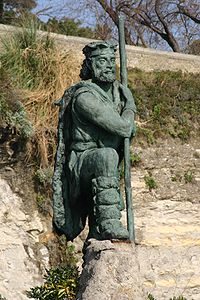- Corocotta
-
 Statue of Corocotta in Santander.
Statue of Corocotta in Santander.
According to several historians of the 20th century, Corocotta was a Cantabrian warrior (Greek: tína lestén én Ibería) leader during the 1st century BC. His great achievement was the union of the disperse Cantabri clans in an alliance against the invading Roman armies, to the great exasperation of the powerful empire.
“ "Besides these traits of his, people also recalled that he did not get blindly enraged at those who had injured him, and that he kept faith even with those who were unworthy of it. For instance, there was a robber named Corocotta, who flourished in Spain, at whom he [ Augustus ] was so angry at first that he offered a million sesterces to the man that should capture him alive; but later, when the robber came to him of his own accord, he not only did him no harm, but actually made him richer by the amount of the reward. (Dio Cassius LVI, 43, 3, transl. E. Cary, Loeb, in [2] ” He fought against Rome from the years 29 BC to 19 BC. The Roman historian Dio Cassius relates the story of this robber who caused numerous difficulties for the Roman Army. Such was his fame that during the campaign of Emperor Augustus in Cantabria from 26-25 BC, a price of 200,000 sestercii was put on his head. To the emperor's astonishment, none other than Corocotta himself walked into the Roman camp, presenting himself and demanding the reward. In a gesture to Corocotta's bravery, the Augustus let him go after granting him the money.
Revision
Recently a Spanish scholar[1] has carried out a review of the Greek text of Cassius Dio LVI, 43, 3, in which she emphasizes, first, that the anecdote (the only ancient reference on Corocotta) is not in Dio's statements on the Cantabrian wars (books 53 and 54) but in 56, after Augustus’s death, cited as an example of his clemency. She comes to the conclusion that this short text does not support the translation and Adolf Schulten's interpretation that has received widespread support in both Spain and internationally since 1943.[2] [3] [4]. Probably Corocotta was neither a hero, nor Cantabri or Hispanic, nor did he have any relationship with the famous wars. She argues that there does not even exist a concrete basis for the anecdote, and therefore for his visiting a Roman camp. She concludes that Corocotta must have been rather a bandit, probably of North African origin who, with the nickname of "The Hyena" (cp. Gr. krokóttas, cf. “The Jackal”), was operating successfully in Iberia. The amount of the reward for his apprehension is also erroneous in many translations: Dión's Greek text says "πέντε καὶ εἴκοσι μυριάδας", i.e. "two hundred fifty thousand", more probably of sesterces. In short, possibly what we have is an "historiographic ghost".
Notes
- ^ Alicia M. Canto in [1] (paper forthcoming).
- ^ A. Schulten, Fontes Hispaniae Antiquae, vol. V (The wars 72-19 BC), Barcelona, 1940, 198, 335.
- ^ A. Schulten, Los cántabros y astures y su guerra con Roma, Madrid, 1943 (reed. 1962, 1969, 2000)
- ^ For instance, the Aufstieg und Niedergang der römischen Welt Bd.3, 1975.
External links
- (Greek) Cassius Dio's original
- (Spanish) Article from El Mundo, a Spanish newspaper
- (Spanish) Corocotta and the Cantabrian War
- (Spanish) see "Tesis norteafricana"
Categories:- History of Spain
- Cantabrian people
- 1st-century BC people
Wikimedia Foundation. 2010.
